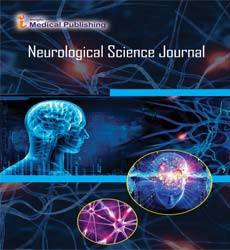A Brief on the Science of Glial Cell and it's Neurology
John Henry*
Department of Neurology, King’s University, London, United Kingdom
- *Corresponding Author:
- John Henry
Department of Neurology,
King’s University,
London,
United Kingdom,
E-mail: henry18john@edu.in
Received Date: August 03, 2021 Accepted Date: August 17, 2021 Published Date: August 24, 2021
Citation: Henry J (2021) A Brief on the Science of Glial Cell and its Neurology. Neurol Sci J Vol. 5 No. 4:2
Description
The audits in the current year's part on 'Neuronal and glial cell science' center ongoing advances being developed, capacity, and illness. One bunch of audits features propels in our comprehension of the atomic instruments that control the determination of neurons and glia, just as how extracellular signs direct these intracellular instruments. A second arrangement of audits depicts investigations of the neural cytoskeleton that have prompted another arrangement of how neuronal construction is shaped and how it is quickly adjusted because of outside improvements. A third arrangement of audits centers around ongoing advances in our agreement of the pathophysiology of hereditary trio rehash illnesses (which influence an assortment of cell organelles prompting neuronal cell passing) and of prion proteins, which are included in spongiform encephalopathy. This issue likewise contains an editorial featuring the new quality chip procedure, which vows to upset cell natural exploration in neurobiology during the coming decade. One of the principal objectives for cell scholars is deciding the atomic premise of cell expansion. How are the large numbers of novel neuronal and glial cell destinies set up during improvement? Three audits in this part address this issue and examine some new strides forward in understanding the natural instruments that control the detail of neural character and in distinguishing the flagging pathways that control cell destiny by controlling these natural broadening systems. In his audit, Anderson (pp 517-524) resolves the topic of how neuronal destiny is determined by zeroing in on the jobs of significant classes of record factors in tangible neurogenesis. This survey is of interest for a few reasons. To start with, it gives a magnificent illustration of how record factor falls with striking similitudes to those that direct neurogenesis in Drosophila lead to the declaration of various blends of terminal neuronal separation qualities that outcome in the age of tactile neurons with diverse axonal projections and capacities. These record factors have as of late been demonstrated to be fundamental for tactile neurogenesis and show up to assist with indicating diverse tangible neuronal destinies. Second, he portrays how these record factors have made it conceivable to explain the means and heredities in tactile neuron age, from multi potential neural peak undifferentiated cells to youthful neurons focused on the tangible pathway to explicit tactile neuron types. Third, he portrays primer, yet thrilling work pointed toward seeing how proprioceptive tactile neurons become gathered into practical circuits with engine neurons. Late investigations have recognized explicit ETS-space record factors found in proprioceptive tactile neurons that are moreover communicated in the engine neurons they innervate. In engine neurons, articulation are exceptionally confined at first, however in tangible neurons, these components are at first communicated generally furthermore, become confined to explicit pools as improvement continues. Hence, these ETS-area record factors may give the coding data important to build up the exemplary sensori-engine reflex curve. How are various kinds of tangible neurons, like proprioceptors, nociceptors, and mechanoceptors, particular to distinguish various kinds of tangible boosts? Caterina and Julius (pp 525-530) audit an assortment of as of late distinguished terminal neuronal separation qualities explicitly communicated by nociceptive tangible neurons that encode receptors and diverts associated with the identification of excruciating upgrades. For instance, the VR1 receptor for capsaicin, the substance that ignites hot peppers, has now been distinguished and cloned. As their audit clarifies, recognizable proof of these new receptors and channels has uncovered an unsuspected heterogeneity of nociceptive neuronal subtypes. Moreover, suddenly, the particular biophysical properties of a portion of these new torment identifying receptors have given understanding into the pathophysiological bases of persistent torment states, including Neuronal and glial cell.
Conclusion
Numerous past audits have zeroed in on parts of pathogenesis and infectivity, yet in his survey, examines late advances in our comprehension of the cell natural parts of prions, including PrPc area, design and geography inside the cell and its ordinary physiological job, just as new experiences about prion wonder from investigations of organisms. As of late has it been understood that PrPc is incorporated in two option topological structures across the plasma layer. Certain transformations can modify the equilibrium of these topological structures, delivering the average neuropath logical provisions of prion infection in transgenic mice. The typical job of PrPc has been a secret, however, amazingly, it just so happens, PC12 cells chose for protection from copper harmfulness express raised degrees of PrPc, proposing a job in copper digestion. At last, filamentous growths have given an intriguing new framework for contemplating engendering and move of prion-like states by proteins, recommending new models of how prions and other irresistible proteinaceous particles might be created. As this survey clarifies, be that as it may, there is a lengthy, difficult experience passed on to go before we comprehend either the ordinary capacity of PrPc in neural cells or how it prompts illness.
Open Access Journals
- Aquaculture & Veterinary Science
- Chemistry & Chemical Sciences
- Clinical Sciences
- Engineering
- General Science
- Genetics & Molecular Biology
- Health Care & Nursing
- Immunology & Microbiology
- Materials Science
- Mathematics & Physics
- Medical Sciences
- Neurology & Psychiatry
- Oncology & Cancer Science
- Pharmaceutical Sciences
